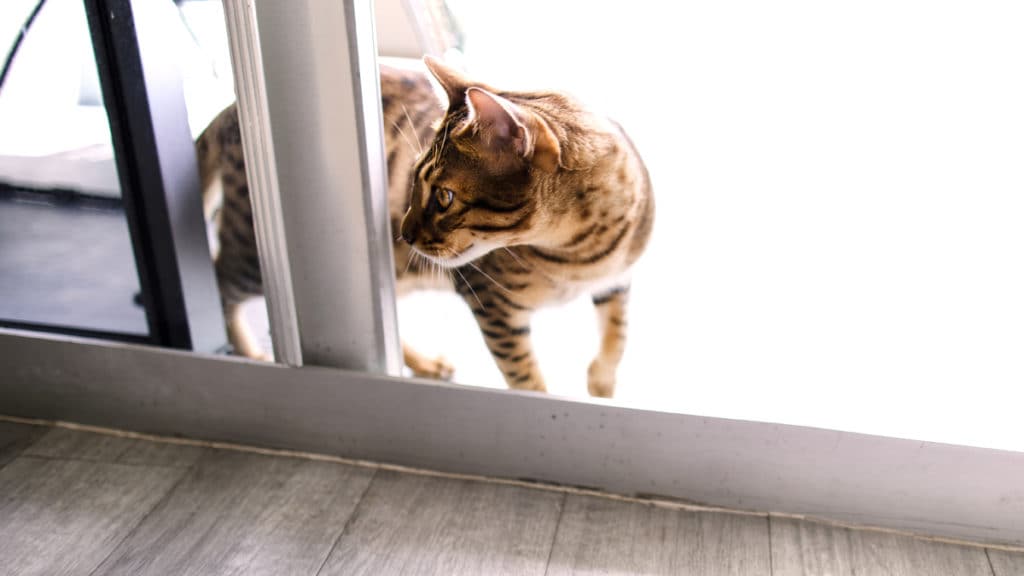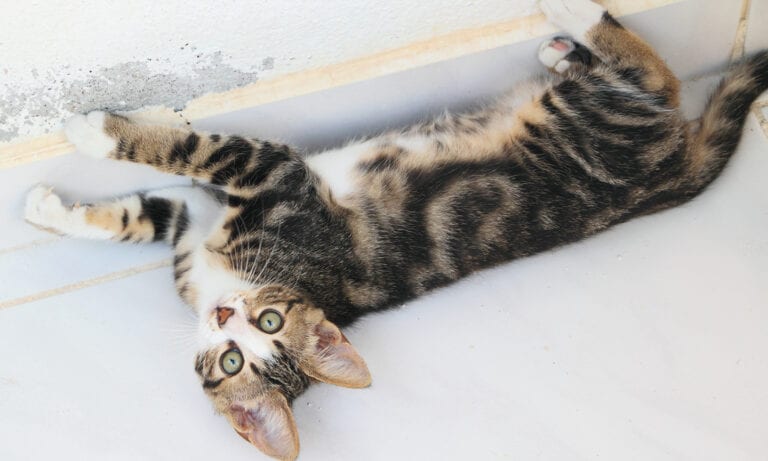Loud visitors with unfamiliar smells, a strange new litter box, a recent addition to the family that wasn’t there the day before—all of these things can really stress a kitty out. Cats getting scared by changes in their home is completely normal. But when your cat is acting scared most of the time, you might start to question whether you are dealing with a generally shy cat or a truly scared cat, and of course, you want to help them feel at ease either way. Samantha Bell, Cat Behavior and Enrichment Lead at Best Friends Animal Society in Los Angeles helps us understand a little more about this area of cat behavior and how we can help out scared cats.
Shy Cat vs. Scared Cat
When your cat acts scared, you probably already know whether your little furball is truly brave and just got frightened, or if she is always more on the meek side and afraid of everything. But it’s pretty hard to determine with kittens, cats you’ve just brought home from the shelter, or those that you’re cat sitting. Samantha points out that “There is no exact, scientific, foolproof way to tell if a cat is a shy cat or an outgoing cat who happens to be scared.” Shy cats are, by nature, scared of more things than their bolder counterparts. Bell notes a few subtle differences in cat behavior to look for:
Shy Cats
A shy cat who is afraid of something would rather disappear, so they will usually make themselves as small and as quiet as they can. Shy cats may hide for weeks or months when frightened (perhaps only coming out to use the litter box or eat).
Bold Cats That Get Frightened
You may see aggressive behaviors when a typically confident cat becomes afraid, like biting or swatting. A bold cat who becomes frightened will usually bounce back faster and return to their outgoing self rather quickly.
Hidden Kitty, Crouching Scaredy Cat
Underneath a raised bed is the go-to hiding spot for shy cats and scared cats who are overwhelmed. Don’t worry when this happens—they will come out eventually, and just need a little space to relax. If your kitty stays under there for a really long time and you’re anxious about it, Bell says it’s important not to pull or try to force them out. Here’s a plan you can follow:
- Sit near the cat, wherever they are hiding, and speak soothingly to them several times a day.
- Offer them a high-value cat food like tuna, Halo Liv-a-Littles freeze-dried treats, or plain chicken baby food, placing it closer to you each time.
- Start placing the food further from the hiding place, and little by little, they should start to emerge.
- If your kitty does come out, try to get her interested in a wand toy instead of approaching her.
“Once they start playing with a wand toy, their confidence will soar!” says Bell. “Food and playtime (and patience) are the keys to getting them out of hiding.”
How to Help Ease Their Stress
When you are dealing with a scared cat, there are plenty of things you can try in order to make their home environment more relaxing and non-threatening. Bell suggests using pheromone diffusers like the Comfort Zone with Feliway Cat Diffuser to lower the stress level. Play some calming music to drown out scary noises like construction work or thunderstorms. If there are neighborhood cats or stray cats outside causing your kitty to feel upset, try blocking out the windows. Pet Naturals of Vermont Calming Cat Chews also seem to be a successful option, and they’re naturally formulated with a chicken liver flavor. And many cats respond to the ThunderShirt Anxiety & Calming Solution for Cats, which helps kitties feel safe and secure.
Once a Shy Cat, Always a Shy Cat?
When they meet new people, many cats are shy at first. Some will start to feel comfortable around house guests and will come out of hiding to explore and satisfy their curiosity. But the really shy cats might just stay hidden for the whole visit. Bell explains that “Cats are born with varying amounts of boldness and timidity, which determine how they act around new people.” A very extroverted kitty might saunter across the living room and walk right up to strangers, or go even further by rubbing against their legs or jumping in their laps and demanding attention.
Sometimes you can tell a kitten’s nature right away, and the shy ones will always be shy. But if you’re adopting an adult cat from a shelter, it can be very hard to tell the difference between truly shy cats and those that are just scared from being in the shelter. The thing to remember is to be patient and accept your cat on her terms, and do your best to help keep her environment as stress-free as possible.

Nikki Naser, BeChewy Senior Editor
Instead of owning 30 cats, Nikki has an impressive collection of 30 cat-themed T-shirts, and just 4 pets—a ginger-haired senior cat, a senior Maine Coon, a middle-aged Choodle, and a young kitty who showed up one day on the back steps. A former Orlando resident, Nikki worked on several tourism publications before moving to South Beach. When she’s not stopping to take pics of community cats to post on Instagram, Nikki spends her time with the office pets at Chewy, writing for their BeChewy blog.
Share:














